warning light Lancia Thema 2013 Owner handbook (in English)
[x] Cancel search | Manufacturer: LANCIA, Model Year: 2013, Model line: Thema, Model: Lancia Thema 2013Pages: 336, PDF Size: 3.87 MB
Page 216 of 336
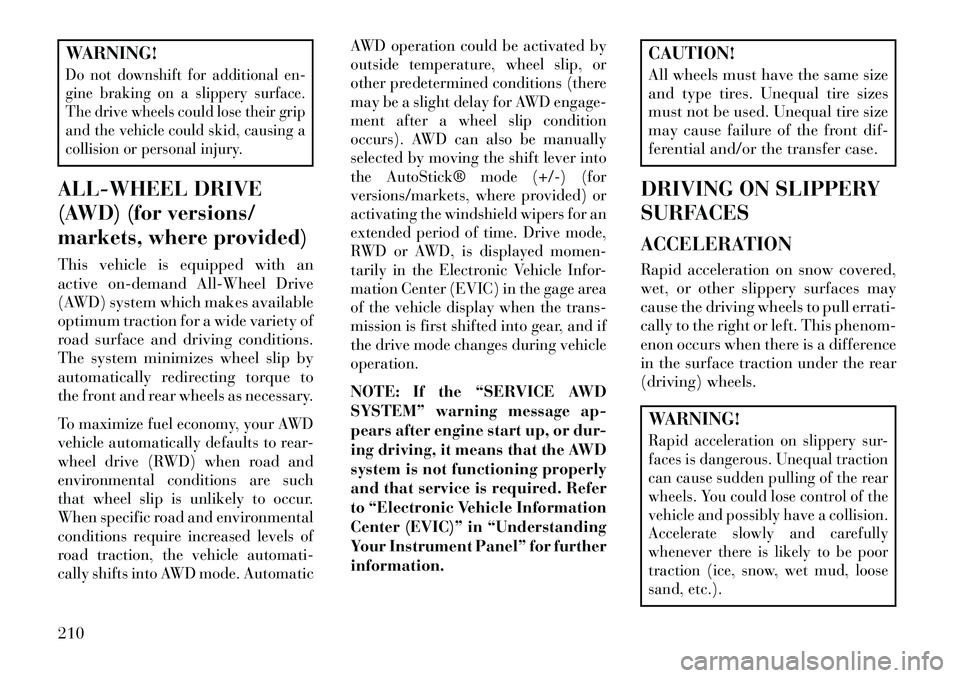
WARNING!Do not downshift for additional en-
gine braking on a slippery surface.
The drive wheels could lose their grip
and the vehicle could skid, causing a
collision or personal injury.ALL-WHEEL DRIVE
(AWD) (for versions/
markets, where provided)
This vehicle is equipped with an
active on-demand All-Wheel Drive
(AWD) system which makes available
optimum traction for a wide variety of
road surface and driving conditions.
The system minimizes wheel slip by
automatically redirecting torque to
the front and rear wheels as necessary.To maximize fuel economy, your AWD
vehicle automatically defaults to rear-
wheel drive (RWD) when road and
environmental conditions are such
that wheel slip is unlikely to occur.
When specific road and environmental
conditions require increased levels of
road traction, the vehicle automati-
cally shifts into AWD mode. AutomaticAWD operation could be activated by
outside temperature, wheel slip, or
other predetermined conditions (there
may be a slight delay for AWD engage-
ment after a wheel slip condition
occurs). AWD can also be manually
selected by moving the shift lever into
the AutoStick® mode (+/-) (for
versions/markets, where provided) or
activating the windshield wipers for an
extended period of time. Drive mode,
RWD or AWD, is displayed momen-
tarily in the Electronic Vehicle Infor-
mation Center (EVIC) in the gage area
of the vehicle display when the trans-
mission is first shifted into gear, and if
the drive mode changes during vehicle
operation.
NOTE: If the “SERVICE AWD
SYSTEM” warning message ap-
pears after engine start up, or dur-
ing driving, it means that the AWD
system is not functioning properly
and that service is required. Refer
to “Electronic Vehicle Information
Center (EVIC)” in “Understanding
Your Instrument Panel” for further
information.
CAUTION!
All wheels must have the same size
and type tires. Unequal tire sizes
must not be used. Unequal tire size
may cause failure of the front dif-
ferential and/or the transfer case.
DRIVING ON SLIPPERY
SURFACES
ACCELERATION
Rapid acceleration on snow covered,
wet, or other slippery surfaces may
cause the driving wheels to pull errati-
cally to the right or left. This phenom-
enon occurs when there is a difference
in the surface traction under the rear
(driving) wheels.WARNING!Rapid acceleration on slippery sur-
faces is dangerous. Unequal traction
can cause sudden pulling of the rear
wheels. You could lose control of the
vehicle and possibly have a collision.
Accelerate slowly and carefully
whenever there is likely to be poor
traction (ice, snow, wet mud, loose
sand, etc.).
210
Page 218 of 336
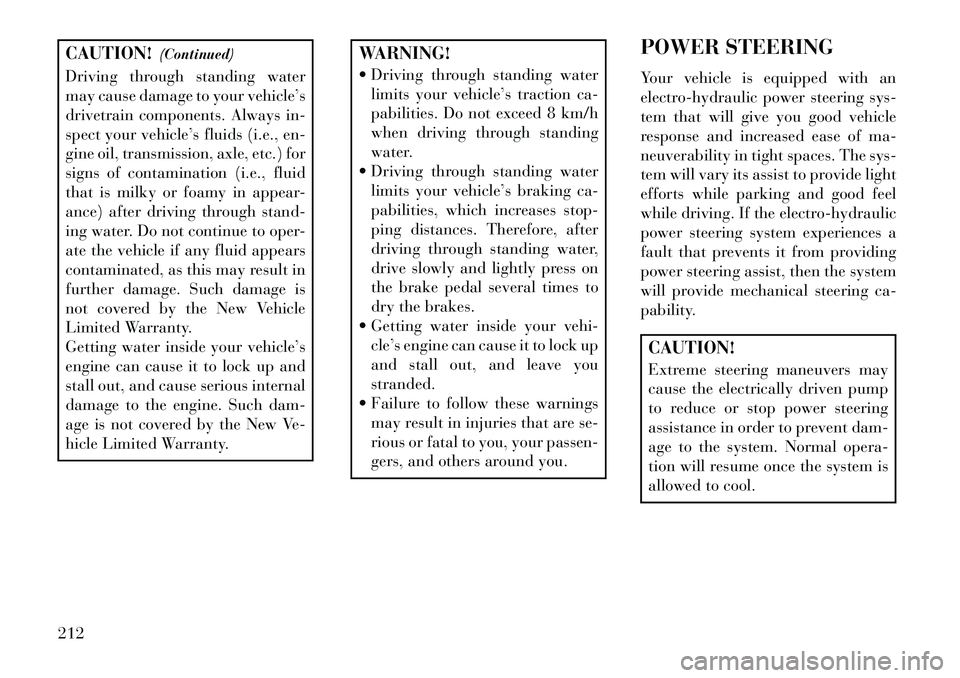
CAUTION!(Continued)
Driving through standing water
may cause damage to your vehicle’s
drivetrain components. Always in-
spect your vehicle’s fluids (i.e., en-
gine oil, transmission, axle, etc.) for
signs of contamination (i.e., fluid
that is milky or foamy in appear-
ance) after driving through stand-
ing water. Do not continue to oper-
ate the vehicle if any fluid appears
contaminated, as this may result in
further damage. Such damage is
not covered by the New Vehicle
Limited Warranty.
Getting water inside your vehicle’s
engine can cause it to lock up and
stall out, and cause serious internal
damage to the engine. Such dam-
age is not covered by the New Ve-
hicle Limited Warranty.
WARNING!
Driving through standing water limits your vehicle’s traction ca-
pabilities. Do not exceed 8 km/h
when driving through standing
water.
Driving through standing water
limits your vehicle’s braking ca-
pabilities, which increases stop-
ping distances. Therefore, after
driving through standing water,
drive slowly and lightly press on
the brake pedal several times to
dry the brakes.
Getting water inside your vehi-
cle’s engine can cause it to lock up
and stall out, and leave you
stranded.
Failure to follow these warnings may result in injuries that are se-
rious or fatal to you, your passen-
gers, and others around you. POWER STEERING
Your vehicle is equipped with an
electro-hydraulic power steering sys-
tem that will give you good vehicle
response and increased ease of ma-
neuverability in tight spaces. The sys-
tem will vary its assist to provide light
efforts while parking and good feel
while driving. If the electro-hydraulic
power steering system experiences a
fault that prevents it from providing
power steering assist, then the system
will provide mechanical steering ca-
pability.
CAUTION!
Extreme steering maneuvers may
cause the electrically driven pump
to reduce or stop power steering
assistance in order to prevent dam-
age to the system. Normal opera-
tion will resume once the system is
allowed to cool.
212
Page 219 of 336

If the “SERVICE POWER
STEERING SYSTEM”
message and a flashing icon
are displayed on the EVIC
screen, it indicates that the vehicle
needs to be taken to the dealer for
service. It is likely the vehicle has lost
power steering assistance. Refer to
“Electronic Vehicle Information
Center (EVIC)” in “Understanding
Your Instrument Panel” for further
information.
If the “POWER STEERING SYSTEM
OVER TEMP” message and an icon
are displayed on the EVIC screen, it
indicates that extreme steering ma-
neuvers may have occurred, which
caused an over temperature condition
in the power steering system. You will
lose power steering assistance mo-
mentarily until the over temperature
condition no longer exists. Once driv-
ing conditions are safe, then pull over
and let vehicle idle for a few moments
until the light turns off. Refer to
“Electronic Vehicle Information Cen-
ter (EVIC)” in “Understanding Your
Instrument Panel” for further infor-
mation. NOTE:
Even if power steering assistance
is no longer operational, it is still
possible to steer the vehicle. Un-
der these conditions there will be
a substantial increase in steering
effort, especially at very low ve-
hicle speeds and during parking
maneuvers.If the condition persists, see your
authorized dealer for service.PARKING BRAKE
Before leaving the vehicle, make sure
that the parking brake is fully applied
and place the shift lever in the PARK
position.
The foot operated parking brake is
located below the lower left corner of
the instrument panel. To apply the
park brake, firmly push the park
brake pedal fully. To release the park-
ing brake, press the park brake pedal
a second time and let your foot up as
you feel the brake disengage.
When the parking brake is applied
with the ignition switch in the ON po-
sition, the “Brake Warning Light” in
the instrument cluster will illuminate.NOTE:
When the parking brake is ap-
plied and the transmission is
placed in gear, the “Brake Warn-
ing Light” will flash. If vehicle
speed is detected, a chime will
sound to alert the driver. Fully
release the parking brake before
attempting to move the vehicle.
This light only shows that the parking brake is applied. It does
not show the degree of brake
application.
Parking Brake
213
Page 220 of 336
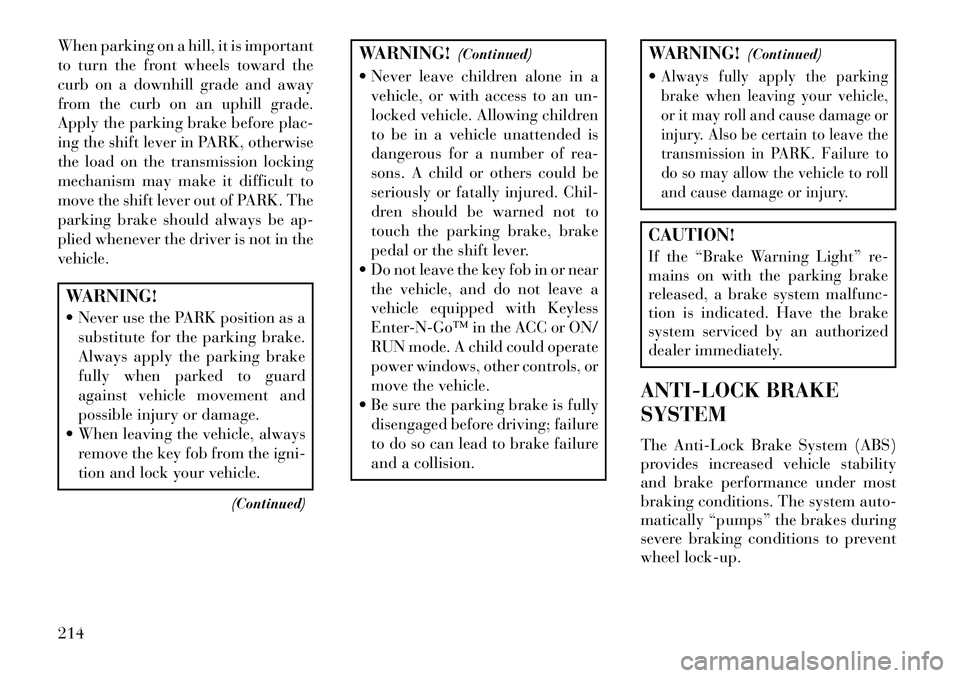
When parking on a hill, it is important
to turn the front wheels toward the
curb on a downhill grade and away
from the curb on an uphill grade.
Apply the parking brake before plac-
ing the shift lever in PARK, otherwise
the load on the transmission locking
mechanism may make it difficult to
move the shift lever out of PARK. The
parking brake should always be ap-
plied whenever the driver is not in the
vehicle.WARNING!
Never use the PARK position as asubstitute for the parking brake.
Always apply the parking brake
fully when parked to guard
against vehicle movement and
possible injury or damage.
When leaving the vehicle, always
remove the key fob from the igni-
tion and lock your vehicle.
(Continued)
WARNING!(Continued)
Never leave children alone in a vehicle, or with access to an un-
locked vehicle. Allowing children
to be in a vehicle unattended is
dangerous for a number of rea-
sons. A child or others could be
seriously or fatally injured. Chil-
dren should be warned not to
touch the parking brake, brake
pedal or the shift lever.
Do not leave the key fob in or near the vehicle, and do not leave a
vehicle equipped with Keyless
EnterNGo™ in the ACC or ON/
RUN mode. A child could operate
power windows, other controls, or
move the vehicle.
Be sure the parking brake is fully disengaged before driving; failure
to do so can lead to brake failure
and a collision.
WARNING! (Continued)
Always fully apply the parking
brake when leaving your vehicle,
or it may roll and cause damage or
injury. Also be certain to leave the
transmission in PARK. Failure to
do so may allow the vehicle to roll
and cause damage or injury.CAUTION!
If the “Brake Warning Light” re-
mains on with the parking brake
released, a brake system malfunc-
tion is indicated. Have the brake
system serviced by an authorized
dealer immediately.
ANTI-LOCK BRAKE
SYSTEM
The Anti-Lock Brake System (ABS)
provides increased vehicle stability
and brake performance under most
braking conditions. The system auto-
matically “pumps” the brakes during
severe braking conditions to prevent
wheel lock-up.
214
Page 221 of 336
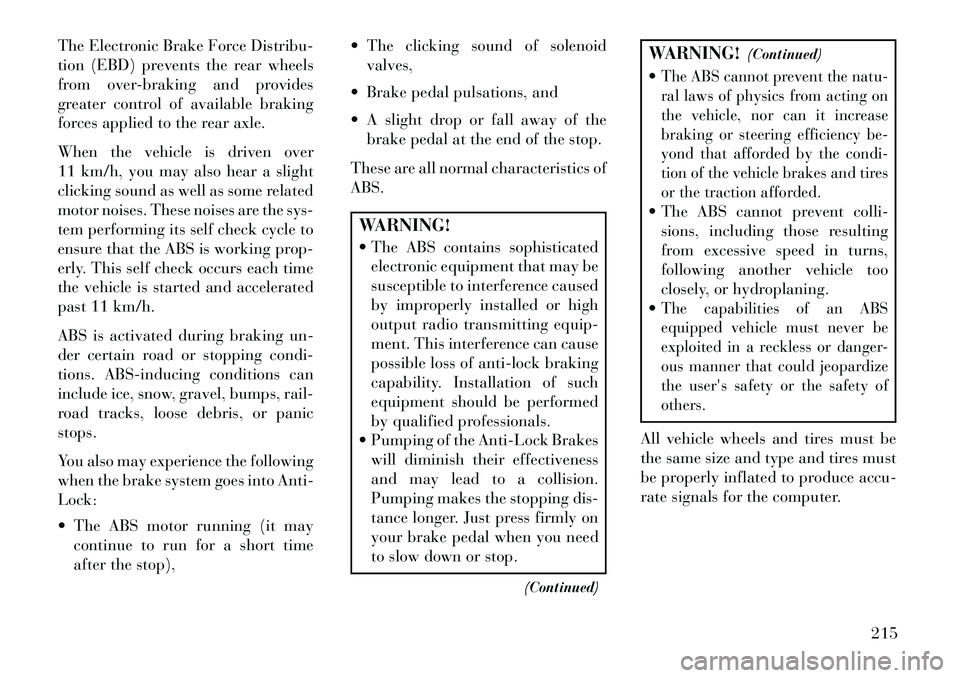
The Electronic Brake Force Distribu-
tion (EBD) prevents the rear wheels
from over-braking and provides
greater control of available braking
forces applied to the rear axle.
When the vehicle is driven over
11 km/h, you may also hear a slight
clicking sound as well as some related
motor noises. These noises are the sys-
tem performing its self check cycle to
ensure that the ABS is working prop-
erly. This self check occurs each time
the vehicle is started and accelerated
past 11 km/h.
ABS is activated during braking un-
der certain road or stopping condi-
tions. ABS-inducing conditions can
include ice, snow, gravel, bumps, rail-
road tracks, loose debris, or panic
stops.
You also may experience the following
when the brake system goes into Anti-
Lock:
The ABS motor running (it maycontinue to run for a short time
after the stop), The clicking sound of solenoid
valves,
Brake pedal pulsations, and
A slight drop or fall away of the brake pedal at the end of the stop.
These are all normal characteristics of
ABS.
WARNING!
The ABS contains sophisticated electronic equipment that may be
susceptible to interference caused
by improperly installed or high
output radio transmitting equip-
ment. This interference can cause
possible loss of anti-lock braking
capability. Installation of such
equipment should be performed
by qualified professionals.
Pumping of the Anti-Lock Brakes will diminish their effectiveness
and may lead to a collision.
Pumping makes the stopping dis-
tance longer. Just press firmly on
your brake pedal when you need
to slow down or stop.
(Continued)
WARNING!(Continued)
The ABS cannot prevent the natu-
ral laws of physics from acting on
the vehicle, nor can it increase
braking or steering efficiency be-
yond that afforded by the condi-
tion of the vehicle brakes and tires
or the traction afforded. The ABS cannot prevent colli- sions, including those resulting
from excessive speed in turns,
following another vehicle too
closely, or hydroplaning.
The capabilities of an ABS
equipped vehicle must never be
exploited in a reckless or danger-
ous manner that could jeopardize
the user's safety or the safety of
others.
All vehicle wheels and tires must be
the same size and type and tires must
be properly inflated to produce accu-
rate signals for the computer.
215
Page 224 of 336

Off” switch and the “ESC Activation/
Malfunction Indicator Light” will illu-
minate. To turn the ESC on again, mo-
mentarily press the “ESC Off” switch
and the “ESC Activation/Malfunction
Indicator Light” will turn off.NOTE:
When in “Partial Off” mode, theTCS functionality of ESC, (ex-
cept for the limited slip feature
described in the TCS section),
has been disabled and the “ESC
Off Indicator Light” will be illu-
minated. All other stability fea-
tures of ESC function normally.
When in “Partial Off” mode, the
engine power reduction feature
of TCS is disabled, and the en-
hanced vehicle stability offered
by the ESC system is reduced.
To improve the vehicle's traction when driving with snow chains,
or when starting off in deep
snow, sand, or gravel, it may be
desirable to switch to the “Par-
tial Off” mode by momentarily
pressing the “ESC Off” switch. Once the situation requiring
“Partial Off” mode is overcome,
turn the ESC on again by mo-
mentarily pressing the “ESC Off”
switch. This may be done while
the vehicle is in motion.
HILL START ASSIST (HSA)
The HSA system is designed to assist
the driver when starting a vehicle
from a stop on a hill. HSA will main-
tain the level of brake pressure the
driver applied for a short period of
time after the driver takes their foot
off of the brake pedal. If the driver
does not apply the throttle during this
short period of time, the system will
release brake pressure and the vehicle
will roll down the hill. The system will
release brake pressure in proportion
to the amount of throttle applied as
the vehicle starts to move in the in-
tended direction of travel.
WARNING!There may be situations on minor
hills (i.e., less than 8%), with a
loaded vehicle, or while pulling a
(Continued)
WARNING! (Continued)trailer, when the system will not
activate and slight rolling may occur.
This could cause a collision with
another vehicle or object. Always
remember the driver is responsible
for braking the vehicle.HSA Activation Criteria
The following criteria must be met in
order for HSA to activate:
Vehicle must be stopped.
Vehicle must be on a 6% (approxi-
mate) grade or greater hill.
Gear selection matches vehicle up- hill direction (i.e., vehicle facing
uphill is in forward gear; vehicle
backing uphill is in REVERSE
gear).
HSA will work in REVERSE and all
forward gears when the activation cri-
teria have been met. The system will
not activate if the vehicle is placed in
NEUTRAL or PARK.
218
Page 225 of 336

WARNING!
There may be situations on minor
hills (i.e., less than 8%), with a
loaded vehicle, or while pulling a
trailer, when the system will not
activate and slight rolling may oc-
cur. This could cause a collision
with another vehicle or object. Al-
ways remember the driver is re-
sponsible for braking the vehicle.
Towing With HSA
HSA will provide assistance when
starting on a grade when pulling a
trailer.WARNING!
If you use a trailer brake control- ler with your trailer, your trailer
brakes may be activated and de-
activated with the brake switch.
If so, when the brake pedal is
released, there may not be enough
brake pressure to hold the vehicle
and trailer on a hill and this could
(Continued)
WARNING!(Continued)
cause a collision with another ve-
hicle or object behind you. In or-
der to avoid rolling down the hill
while resuming acceleration,
manually activate the trailer
brake prior to releasing the brake
pedal. Always remember the
driver is responsible for braking
the vehicle.
HSA is not a parking brake. Al- ways apply the parking brake
fully when leaving your vehicle.
Also, be certain to leave the trans-
mission in PARK. Failure to fol-
low these warnings may cause the
vehicle to roll down the incline
and could collide with another
vehicle, object or person, and
cause serious or fatal injury. Al-
ways remember to use the park-
ing brake while parking on a hill
and that the driver is responsible
for braking the vehicle. NOTE:
The HSA system may also
be turned on and off if the vehicle
is equipped with the Electronic
Vehicle Information Center (EVIC).
Refer to “Electronic Vehicle Infor-
mation Center (EVIC)” in “Under-
standing Your Instrument Panel”
for further information.
HSA Off
If you wish to turn off the HSA sys-
tem, it can be done using the Cus-
tomer Programmable Features in the
Uconnect Touch™ System. Refer to
“Uconnect TOUCH™ SETTINGS” in
“Understanding Your Instrument
Panel” for further information.
219
Page 237 of 336

WARNING!
Fast spinning tires can be danger-
ous. Forces generated by excessive
wheel speeds may cause tire dam-
age or failure. A tire could explode
and injure someone. Do not spin
your vehicle's wheels faster than
48 km/h or for more than 30 sec-
onds continuously when you are
stuck, and do not let anyone near a
spinning wheel, no matter what the
speed.TREAD WEAR INDICATORSTread wear indicators are in the origi-
nal equipment tires to help you in
determining when your tires should
be replaced.These indicators are molded into the
bottom of the tread grooves. They will
appear as bands when the tread depth
becomes 2 mm. When the tread is
worn to the tread wear indicators, the
tire should be replaced.
LIFE OF TIRE
The service life of a tire is dependent
upon varying factors including, but
not limited to:
Driving style
Tire pressure
Distance driven
WARNING!
Tires and the spare tire should be
replaced after six years, regardless
of the remaining tread. Failure to
follow this warning can result in
sudden tire failure. You could lose
control and have a collision result-
ing in serious injury or death.
Keep dismounted tires in a cool, dry
place with as little exposure to light as
possible. Protect tires from contact
with oil, grease, and gasoline. REPLACEMENT TIRES
The tires on your new vehicle provide
a balance of many characteristics.
They should be inspected regularly
for wear and correct cold tire inflation
pressure. The manufacturer strongly
recommends to always respect the
sizes of the tires given in the Registra-
tion Documentation/Certificate and
that you use tires equivalent to the
originals in size, quality and perfor-
mance when replacement is needed.
(Refer to the paragraph on “Tread
Wear Indicators”). Refer to the “Tire
and Loading Information” placard
for the size designation of your tire.
The Load Index and Speed Symbol
for your tire will be found on the
original equipment tire sidewall. See
the Tire Sizing Chart example found
in the Tire Safety Information section
of this manual for more information
relating to the Load Index and Speed
Symbol of a tire.
It is recommended to replace the two
front tires or two rear tires as a pair.
Replacing just one tire can seriously
affect your vehicle’s handling. If you
ever replace a wheel, make sure that
1 — Worn Tire
2 — New Tire
231
Page 240 of 336

TIRE PRESSURE
MONITOR SYSTEM
(TPMS)
The Tire Pressure Monitor System
(TPMS) will warn the driver of a low
tire pressure based on the vehicle rec-
ommended cold placard pressure.The tire pressure will vary with tem-
perature by about 0.07 BAR for every
7°C. This means that when the outside
temperature decreases, the tire pressure
will decrease. Tire pressure should al-
ways be set based on cold inflation tire
pressure. This is defined as the tire pres-
sure after the vehicle has not been
driven for at least three hours, or driven
less than 1.6 km after a three hour
period. The cold tire inflation pressure
must not exceed the maximum inflation
pressure molded into the tire sidewall.
Refer to “Tires – General Information”
in “Starting and Operating” for infor-
mation on how to properly inflate the
vehicle’s tires. The tire pressure will also
increase as the vehicle is driven - this is
normal and there should be no adjust-
ment for this increased pressure.
The TPMS will warn the driver of a
low tire pressure if the tire pressure
falls below the low-pressure warning
limit for any reason, including low
temperature effects and natural pres-
sure loss through the tire.
The TPMS will continue to warn the
driver of low tire pressure as long as
the condition exists, and will not turn
off until the tire pressure is at or above
the recommended cold placard pres-
sure. Once the low tire pressure warn-
ing (Tire Pressure Monitoring [TPM]
Telltale Light) illuminates, you must
increase the tire pressure to the rec-
ommended cold placard pressure in
order for the TPM Telltale Light to
turn off. The system will automati-
cally update and the TPM Telltale
Light will turn off once the system
receives the updated tire pressures.
The vehicle may need to be driven for
up to 20 minutes above 24 km/h in
order for the TPMS to receive this
information.For example, your vehicle may have a
recommended cold (parked for more
than three hours) placard pressure of
2.1 BAR. If the ambient temperature
is 20°C and the measured tire pres-
sure is 1.9 BAR, a temperature drop to
7°C will decrease the tire pressure to
approximately 1.6 BAR. This tire
pressure is sufficiently low enough to
turn ON the TPM Telltale Light. Driv-
ing the vehicle may cause the tire
pressure to rise to approximately 1.9
BAR, but the TPM Telltale Light will
still be ON. In this situation, the TPM
Telltale Light will turn OFF only after
the tires are inflated to the vehicle’s
recommended cold placard pressure
value.
234
Page 241 of 336
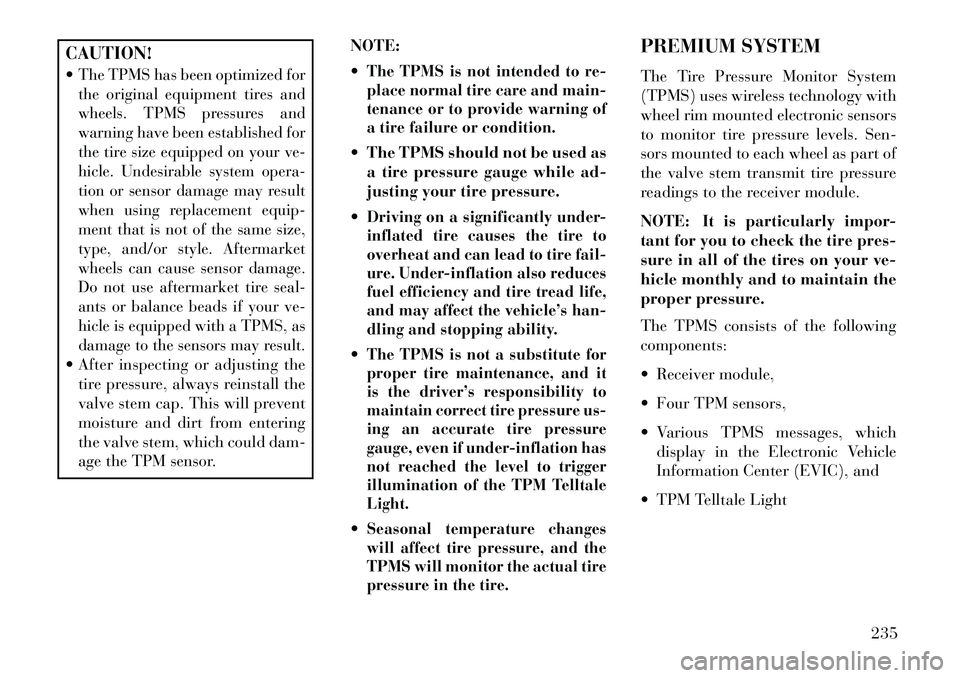
CAUTION!
The TPMS has been optimized for
the original equipment tires and
wheels. TPMS pressures and
warning have been established for
the tire size equipped on your ve-
hicle. Undesirable system opera-
tion or sensor damage may result
when using replacement equip-
ment that is not of the same size,
type, and/or style. Aftermarket
wheels can cause sensor damage.
Do not use aftermarket tire seal-
ants or balance beads if your ve-
hicle is equipped with a TPMS, as
damage to the sensors may result. After inspecting or adjusting thetire pressure, always reinstall the
valve stem cap. This will prevent
moisture and dirt from entering
the valve stem, which could dam-
age the TPM sensor. NOTE:
The TPMS is not intended to re-
place normal tire care and main-
tenance or to provide warning of
a tire failure or condition. The TPMS should not be used as
a tire pressure gauge while ad-
justing your tire pressure.
Driving on a significantly under-
inflated tire causes the tire to
overheat and can lead to tire fail-
ure. Under-inflation also reduces
fuel efficiency and tire tread life,
and may affect the vehicle’s han-
dling and stopping ability.The TPMS is not a substitute for
proper tire maintenance, and it
is the driver’s responsibility to
maintain correct tire pressure us-
ing an accurate tire pressure
gauge, even if under-inflation has
not reached the level to trigger
illumination of the TPM Telltale
Light.Seasonal temperature changes
will affect tire pressure, and the
TPMS will monitor the actual tire
pressure in the tire.
PREMIUM SYSTEM
The Tire Pressure Monitor System
(TPMS) uses wireless technology with
wheel rim mounted electronic sensors
to monitor tire pressure levels. Sen-
sors mounted to each wheel as part of
the valve stem transmit tire pressure
readings to the receiver module.
NOTE: It is particularly impor-
tant for you to check the tire pres-
sure in all of the tires on your ve-
hicle monthly and to maintain the
proper pressure.
The TPMS consists of the following
components:
Receiver module,
Four TPM sensors,
Various TPMS messages, which display in the Electronic Vehicle
Information Center (EVIC), and
TPM Telltale Light
235